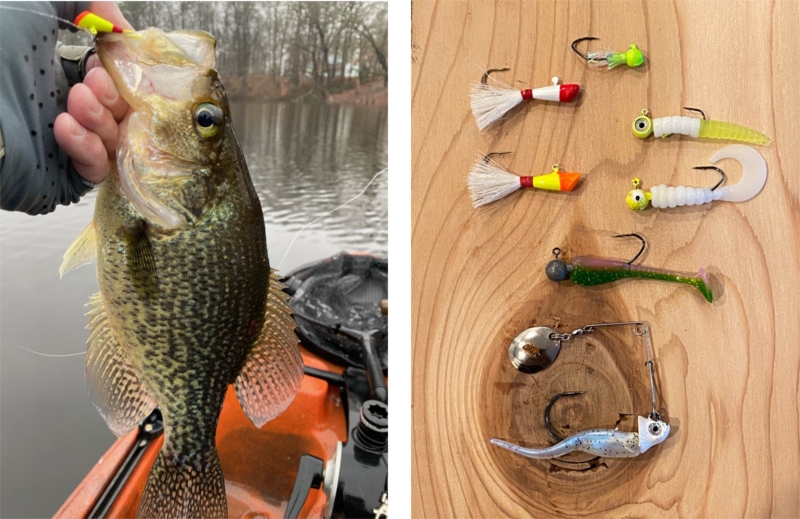As the water temperatures start to drop there is no need to stop dropping jigs on top of schooling crappie. Here in the Mid-Atlantic region, you will find black crappie in most reservoirs, rivers, and ponds, and they are easy to access via kayak year-round. Let’s head out to the lake and find a few of those delicious table fair we call crappie — but before we go we need to get our gear together. A light spinning rod in the six and a half- to seven-foot length, with a reel that holds six to 12-pound-test line, works well for me. I find that using ultralight tackle during winter months makes it harder to hook up because the rods are too light to get the quick reaction time needed to set the hook.

I will fish a 1/16- up to 1/4-ounce jig with small plastics in white, chartreuse, a combination of white and chartreuse, and electric chicken. The plastics are either a simple grub, paddle tail, or twister tail. When I fish a paddle tail or twister tail I may add a small blade to give the bait some flash.
As water temperatures drop crappie will start schooling up and moving into deeper water, following the bait. I start by looking for the fish on the fish finder, searching around drop offs, concrete structures, and flooded timber. Where the water depth drops from four to 14 feet or deeper you may find crappie stacked up from as shallow as two feet under the water’s surface and down. Once you find the fish drop a jig right on top of the school, slowly moving the jig vertically. As the water temperatures drop you may need to move the bait even slower. There are times that it’s most effective to let the waves gently rocking your kayak do the work, holding your rod horizontally and letting the wave action move the bait up and down. You will need to vary your speed to see what they are biting on any particular day.
If you find that the bite stops after catching a few fish you may need to back off and cast towards the school of fish, causing less disruption. There are times that the presence of even a stealthy kayak will be enough to tip them off.
Another tactic that sometimes works well is trolling a small jig with a spinner through the school. You can also slow-troll a few jigs under a bobber. This technique works well fishing the shallow millponds on the Eastern Shore, where the maximum water depth is in the range of six to 10 feet.
Also look for concrete structures while hunting crappie. Bridge pilings and reservoir drain intakes are prime crappie attractors, they heat up in the sun, warming the surrounding water and thereby attracting baitfish.
You can find crappie over deep brush also, such as old Christmas trees that have been placed in the water as fish attractors. The Eastern Shore mill ponds have been populated with old Christmas trees over the years and are the perfect place to drop a minnow or two.
Minnows are the prime choice for crappie fishing with live bait. Placing a small hair jig under a bobber with a minnow lip-hooked will produce. Fishing the same locations as mentioned above with minnows works well, but you will need to get the minnow into the correct zone in the water column. Wintertime fish will not travel far to get a meal, so you need to get your bait into the depth range, and play with various depths until you find the fish.
Last words on winter fishing in a kayak: slow things down and use the wind to your advantage in your boat. Your bait will get a natural cadence and this will increase your chances of a bite.
There you have it — and remember, a cast not taken is a fish not caught.
- By Eric Packard